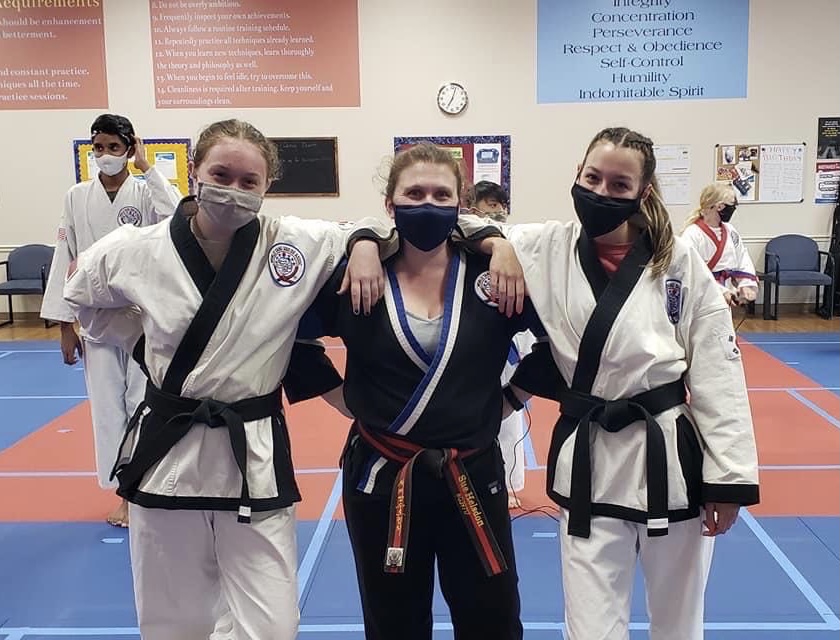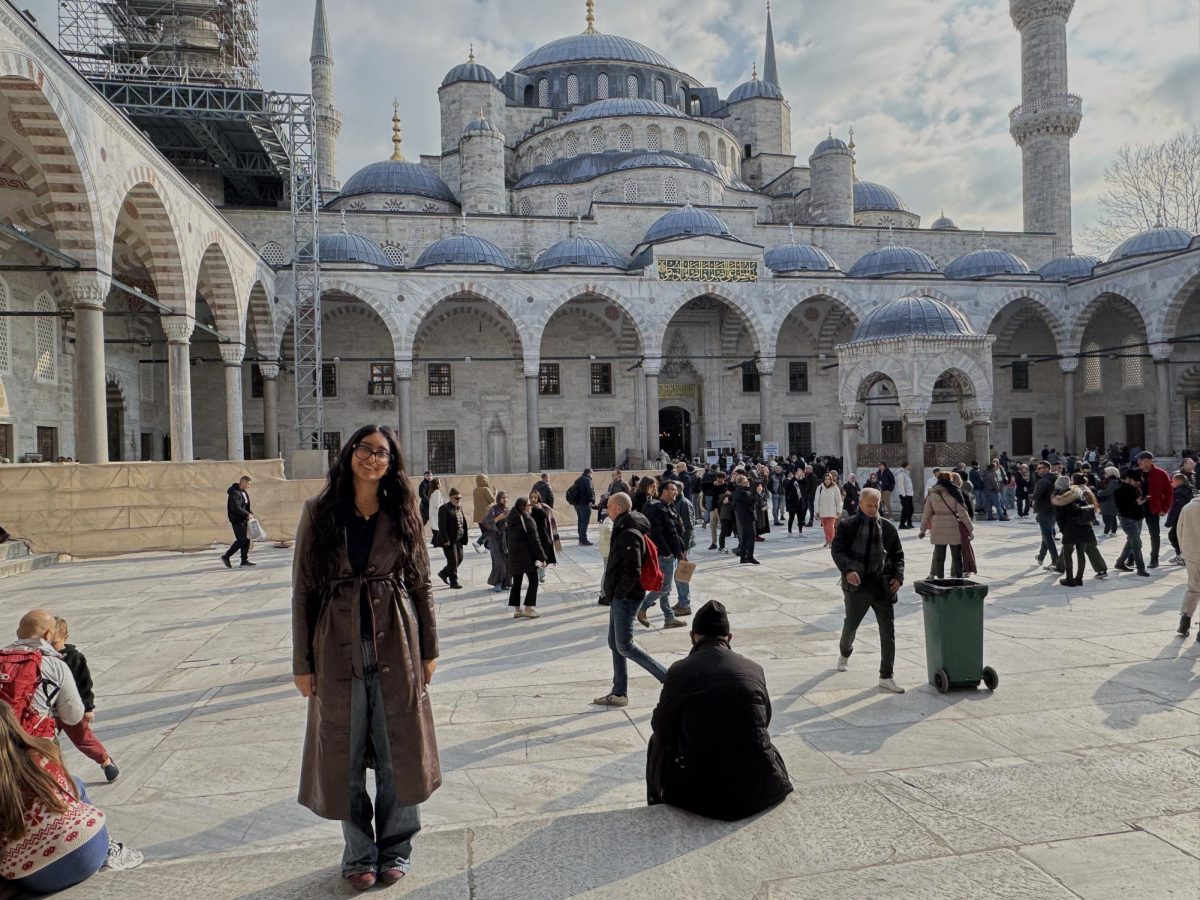Karate takes a new turn during COVID-19
Through the darkness of COVID-19, martial artists found their sunshine in the karate studio.
December 3, 2021
COVID-19 has impacted people’s lives in more ways than anyone could count. It has impacted school life, work life, home life and sports life. For martial artists, COVID-19 has become more of a hassle than a pandemic.
Just like at school, in the midst of the pandemic martial artists had to use Zoom as their main way of learning their forms, working out and teaching. For a year and a half, Zoom was the main source of everything regarding martial arts, but it wasn’t always a fun or engaging way to perform.
Master Susan Helsdon is a main instructor at True Balance Karate in Downers Grove. She was able to see the behind-the-scenes of Zoom karate. She had to watch many of her students’ skill levels not improve as the year went on.
“People were no longer able to target where they were headed… they were unable to have the tactical feedback because of COVID-19,” Helsdon said.
The idea of being able to stand on a gross, sweaty mat went from a daily task to a dream for freshman Jack Sifuentes and sophomore Grace Krause who are both second-degree black belts in Tang Soo Do.
“When I’d have to do karate on Zoom, I’d sit in my karate room and watch people do karate on the screen. Half the time I wasn’t paying attention, but I was looking out the window,” Sifuentes said.
Sitting in front of a screen is not as fun as the real thing. Just as we did for school, these two would have to do for their favorite sport in the world. Students who had the splits, flip kicks and many other skills before COVID-19 came back without them.
“I had lost a lot of progress I made before COVID-19 on Zoom,” Krause said.
Many students, including Krause, had to do their karate classes in their bedroom or a hallway. This did not leave much room to go all out while practicing.
The Hwang Dan League is a group of skilled 18 year old and under students from around the world that would meet a few times a year and practice skills and forms that they would go on to perform at big events like Nationals or World Championships. These kids were unable to show off what they had learned in an advanced setting. They would have YouTube videos and meet a few times over Zoom, but that would confuse some students in the group even more.
“Zoom was frustrating because they never knew if they were talking to you or the little square next to you,” Sifuentes said.
Yet after many long and hard months of doing karate on a little tiny box in the corner of the screen, students were finally allowed to come back into the building. This opened up an entirely new world for martial artists; it wasn’t back to normal, but it wasn’t as difficult anymore. They were finally able to do what they loved in a comfortable environment instead of in their house awkwardly around their families.
Students would be in six foot boxes with two foot isles in between each box. This did not leave very much room for many students, so there were about 19 students allowed in each class. Despite the lack of room, most students were just happy to be back on the newly disinfected mat.
Although the students were ready to come back onto the mat, many instructors were terrified with the what-ifs that came with sending everyone back inside.
“The first class inside, with six-foot boxes and masks on, I was nauseous the whole day… I had to ask myself if we were doing the right thing by sending everyone back to the studio.” Helsdon said.
From an instructor’s point of view, this was a frightening experience that would have never come to mind before 2020.
“I was nervous about seeing everybody back in the building and making sure [students] stayed safe and well and didn’t bring it back to their families… nobody needs to get sick while doing karate,” Helsdon said.
The next few months were getting back in the groove of in-studio classes and no more Zoom meetings, although Zoom was still an option for students who were uncomfortable coming back or were out of town.
With everyone being back in their studios the World Tang Soo Do association brought back competition. Region five of The World Tang Soo Do association had their regional tournament on Sept. 25 with a black belt workout on Sept. 26. Martial Artists from Michigan, Indiana, Illinois and Wisconsin all competed.
This was the first time in almost two years that martial artists were able to do their open hand forms, weapon forms, and spar in front of a panel of judges.
This brought back the excitement of regional friends and fun competition, but numerous contenders, including Krause, did not meet their expectations.
“It was very exciting to get back into the competition, but I didn’t compete as well as I normally did because my skill level hasn’t been as high as in the past,” said Krause.
Although not competing as well as they hoped many athletes moved on to the national level competing two weeks later on Oct. 8.
At nationals, The World Tang Soo Do Grandmaster William Strong got promoted to Ninth Degree Master. Watching this is a once-in-a-lifetime opportunity that not many people get to witness. Usually, anyone who wanted to would be able to watch Strong get promoted, but this was unavailable at nationals due to COVID-19 precautions.
“I have seen two grandmaster promotions to ninth degree… how they chose to do it this year was similar as the last with the walking in of the master’s sword, the walking in of the belt and the walking in of Grandmaster himself. There was still joy and excitement in the room,” Helsdon said.
Only a select group of masters belts were allowed to watch. Others would sit in the lobby, in their hotel rooms or in the comfort of their own homes and watch the live stream on YouTube.
“It was a blessing and a memory that I will carry with me… I felt honored to be in the room.” Helsdon said.
Although the national and regional competitions were fun, they were not the same as in the past. The HDL group was unable to perform their skills and there was limited space for spectators.
The past two years have been a struggle for martial artists everywhere; Zoom became a norm, masks became part of our uniform and tournaments were postponed or canceled. Many have quit and hung up their belts but others have persisted and kept going.
The World Tang Soo Do Association is still growing and thriving, and even with COVID-19, they will continue to snowball into a larger group of strong athletes throughout the world.




